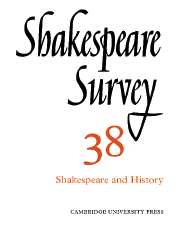Book contents
- Frontmatter
- Shakespeare’s History Plays: 1952–1983
- Shakespeare and History: Divergencies and Agreements
- Shakespeare’s Georgic Histories
- The Nature of Topicality in Love’s Labour’s Lost
- The Tragic Substructure of the Henry IV Plays
- Hal and the Regent
- The Rite of Violence in I Henry IV
- The Fortunes of Oldcastle
- Hand D in Sir Thomas More: An Essay in Misinterpretation
- Livy, Machiavelli, and Shakespeare’s Coriolanus
- Henry VIII and the Ideal England
- The Strangeness of a Dramatic Style: Rumour in Henry VIII
- ‘Edgar I Nothing Am’: Figurenposition in King Lear
- ‘Very like a whale’: Scepticism and Seeing in The Tempest
- Shakespeare’s Medical Imagination
- Shakespeare in the Theatrical Criticism of Henry Morley
- Shakespeare Performances in Stratford-upon-Avon and London 1983–4
- The Year's Contributions to Shakespearian Study 1 Critical Studies
- 2 Shakespeare’s Life, Times and Stage
- 3 Editions and Textual Studies
- Index
Hand D in Sir Thomas More: An Essay in Misinterpretation
Published online by Cambridge University Press: 28 March 2007
- Frontmatter
- Shakespeare’s History Plays: 1952–1983
- Shakespeare and History: Divergencies and Agreements
- Shakespeare’s Georgic Histories
- The Nature of Topicality in Love’s Labour’s Lost
- The Tragic Substructure of the Henry IV Plays
- Hal and the Regent
- The Rite of Violence in I Henry IV
- The Fortunes of Oldcastle
- Hand D in Sir Thomas More: An Essay in Misinterpretation
- Livy, Machiavelli, and Shakespeare’s Coriolanus
- Henry VIII and the Ideal England
- The Strangeness of a Dramatic Style: Rumour in Henry VIII
- ‘Edgar I Nothing Am’: Figurenposition in King Lear
- ‘Very like a whale’: Scepticism and Seeing in The Tempest
- Shakespeare’s Medical Imagination
- Shakespeare in the Theatrical Criticism of Henry Morley
- Shakespeare Performances in Stratford-upon-Avon and London 1983–4
- The Year's Contributions to Shakespearian Study 1 Critical Studies
- 2 Shakespeare’s Life, Times and Stage
- 3 Editions and Textual Studies
- Index
Summary
The literary and dramatic qualities of the addition in Hand D to the manuscript of The Booke of Sir Thomas Moore are outside of my brief here. I am not concerned with its artistic value per se, or with the identification of Hand D with Shakespeare or any other Elizabethan playwright. What is disturbing, I feel, is that those three pages have been from the beginning and are still beset, even at a merely textual approach, by a number of misunderstandings and misinterpretations. No doubt this is largely due to the state of the manuscript, with all the deletions, corrections, interlineations and additions in two separate hands which, following Greg’s critical edition of 1911 for the Malone Society, we are accustomed to call D and C. There have been since a number of more and more sophisticated and annotated diplomatic transcriptions of the text, beginning with Greg himself in the appendix to the collective volume Shakespeare’s Hand in the Play of ‘Sir Thomas More’ (Cambridge, 1923), reprinted in Peter Alexander’s Tudor Shakespeare (1951), Thomas Clayton (The ‘Shakespearean’ Addition to The Booke of Sir Thomas Moore, Shakespeare Studies Monographs, 1, Dubuque, Iowa, 1969), and finally G. Blakemore Evans (Riverside Shakespeare, Boston, 1974); but in spite of the fact that they provide in visual terms clear representations of the actual state of the manuscript, the necessary inclusion in them of all the alterations it originally underwent obscures to a certain extent a precise understanding of the intentions of D when he first drafted it.
- Type
- Chapter
- Information
- Shakespeare Survey , pp. 101 - 114Publisher: Cambridge University PressPrint publication year: 1986

